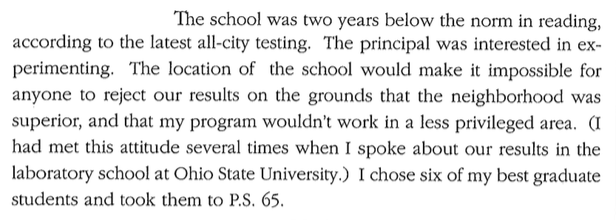Lou LaBrant and Teacher Education’s Enduring Legacy

A colleague of Louise Rosenblatt at New York University, Lou LaBrant faced mandatory retirement when she turned 65 in 1953. Reflecting on her work at NYU as a teacher educator from 1942-1953, LaBrant wrote in 1988 “Public School 65, Down on the Lower East Side” as she turned 100.
LaBrant noted “that [New York City] requirements seemed to me inadequate for those who already spoke the language clearly but needed a richer background” (p. 6). Candidates for teaching English, LaBrant argued, needed greater linguistic understanding and experiences grounded in the complex Germanic and Latinate roots of English.
But other regulations also impeding LaBrant’s goals, including restrictions on the number of student teachers placed in each school. Circumventing that restriction, however, LaBrant placed 6 teacher candidates at “P.S. 65, a junior high school on the Lower East Side, known as one of the worst slum areas in the city” (p. 7). LaBrant then explained her choice (p. 7):
Next, LaBrant built her program and the experience for the student teachers on the characteristics of the students being taught—a progressive and student-centered approach toscientific education. The students at P.S. 65, they found, had very limited experiences with the wider city, lived in cramped and poorly lit housing, had no books or reading materials in the home, had life experience unlike the national research on student reading interests, and attended a school in which “[t]eachers did not welcome an assignment to the area and within ten minutes after the final gong were on their way to the subway to avoid the five o’clock rush” (p. 8).
In that context, LaBrant’s program included taking students on bus trips to explore the city, having librarians provide students time and opportunities to examine and choose books that matched their interests, committing to not requiring book reports, and creating an overarching goal that “[s]chool was to become a pleasant place” for students and their teachers.
Key, as well, was LaBrant’s rejecting deficit views of race, literacy, and poverty that pervaded popular practices: “This simple program did not depend on the theories about word count, word recognition, left-handedness, or any of the educational fads then popular” (p. 9). This “simple” approach to teaching reading was a hallmark of LaBrant’s work, including herrejecting reading programs as “costume parties” (LaBrant, 1949).
And while LaBrant admitted she did not know the long-term results of her work, she did note Lou LaBrant and Teacher Education’s Enduring Legacy | the becoming radical:

